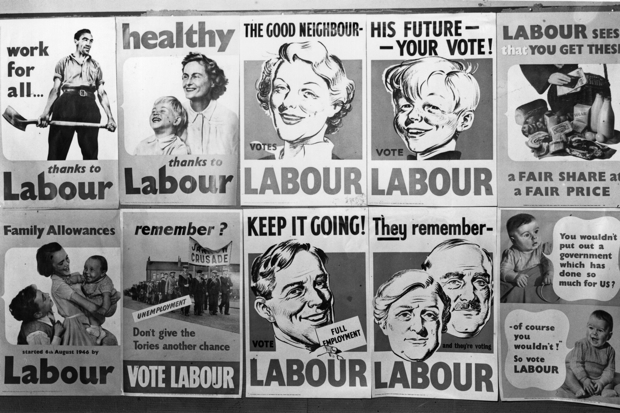What’s Labour’s problem? Following its fantastic drubbing at the polls, the most common answer to that question is that the party has for too long ignored its traditional base: working-class voters.
Among media Labourites in particular, those currently writing emotionally unhinged articles about how isolated they feel in this cruel new Britain — bless ’em — this has become the go-to excuse for Labour’s rubbishness in recent years.Yes, there’s the issue of Tory-backing Rupert Murdoch’s stranglehold on people’s mushy minds, they say, revealing their disdain for tabloid readers. And there’s the apparently irresistible lure of the Tories’ politics of fear, which they believe ensnared a dumb electorate, once again exposing their low view of the little people.
But the main reason for Labour’s decline, according to these sad-eyed scalpel-wielders currently poised over Labour’s corpse, is that the party ‘left behind’ its old voters, ignoring them in favour of cosying up to businesspeople in the Blair years and being too nerdish to connect with them in the Miliband years.This theory gets things the wrong way round. The real problem facing Labour isn’t that the party turned its back on working-class voters — it’s that working-class voters turned their backs on the party, and have been doing so for nearly 50 years. Back when Blair, alleged destroyer of Old Labour, was a swottish student, working-class voters had already started their historic desertion of Labour. Labour’s epic crisis is not a case of ‘left-behind voters’ but of a ‘left-behind party’, rejected by the very people it was founded to represent.
The working classes have been leaving Labour behind for years. As Robert Garner and Richard Kelly argued in their book British Political Parties Today, over the past five decades ‘the most striking feature of voting behaviour was the working-class desertion of Labour’.
In 1966, 69 per cent of manual workers gave their X to Labour at election time. This number waned through the 1970s and 1980s until, by 1987, only 45 per cent of manual workers voted Labour. The greatest desertion was among skilled manual workers. Between 1945 and the end of the 1950s, around 60 per cent of these workers supported Labour; by the time of the mid-1980s only 34 per cent did. So back when New Labour was not even a spark in Mandelson’s mind, Labour had gone from enjoying the support of around two-thirds of skilled manual workers to being backed by just a third of them. By the end of the 1980s, academic Ivor Crewe could argue that ‘Labour’s claim to be the party of the working class [is] sociologically, if not ideologically, threadbare’. There was a return of working-class voters to Labour in 1997, but it was brief. Fifty-eight per cent of working-class voters went for Blair in 1997, which was actually lower than the proportion who supported Labour in the 1940s and 50s. Strikingly, in 2005, when Labour won again but with a reduced majority, it was mainly working-class voters who withdrew their support. Only around 2 per cent of Labour voters in the professional AB class failed to vote Labour in 2005, while in social classes C1, C2 and DE around 20 per cent of those who had voted Labour in 2001 didn’t vote for it in 2005. Labour was being sustained by the middle classes, while lower classes went back to the thing they’d been doing for decades: deserting Labour.The Blairites are often accused of ruining Labour, abandoning its traditional voters and ideals. This turns history upside down. New Labour is better understood as a response to something that had already happened: the slow but sure abandonment of Labour by working-class voters, which left Labour a shell, ripe for a takeover by a middle-class professional set. It was working-class voters who sealed Labour’s fate, not Labour that sealed theirs.
This isn’t semantics, this question of who abandoned whom. Yes, it’s all interrelated: working-class voters deserted Labour because they felt the party had in some way screwed them over. Chicken, egg, etc. But understanding that working-class voters have been turning their backs on Labour for ages is important, because it shows that the crisis facing this party today is more profound — infinitely more profound — than the current post-election soul-searching lets on. For what we have is a party whose foundation stone, whose very reason for existing — to represent the working classes — no longer exists. Labour is facing more than a crisis of communication or a dearth of likeable leaders. It’s facing a crisis that is about as existential as it is possible to get: what becomes of a party whose founding constituency just isn’t into it anymore? All the talk of reviving Labour with a re-injection of New Labour or Blue Labour or Brownite Labour is like discussing what colour lipstick to put on a corpse. Labour is dead. Its soul — working-class voters — has gone. It’s now little more than a zombie party being puppet-mastered by metropolitan elites and the media classes in a bizarre political danse macabre. A Frankenstein escaped from the 20th century. Well, they can keep it, these Labour-sustaining luvvies, because working-class voters have no more need of it: they’ve made Labour a left-behind party.






Comments